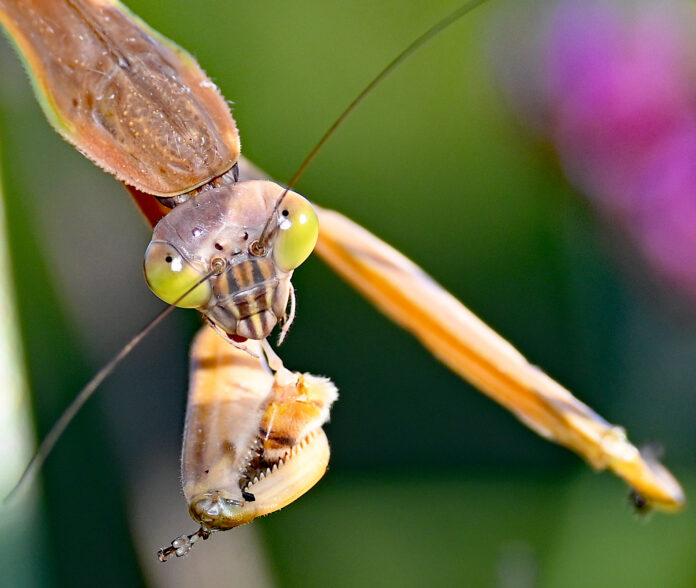
I have a hard time trying to understand why so many people find the praying mantis so endearing. Just because it sports a holy name, doesn’t make it so. After all, what is to love about an alien-looking creature that turns its head to stare at you no matter what your position, stealthily stalks and nabs its unsuspecting prey from flowers, slowly consuming them while they are still alive, and, to top it all off, devours its mate shortly after copulation. Just what can be so blessed about such qualities?
Native mantid
There are around 2,000 species of mantids throughout the world, 20 of which are native to the United States. Here in the northeast, there are three species of mantids that occur and only one of them is native. This latter, the Carolina mantis (Stagmomantis Carolina) is found throughout much of the United States and is the smallest of the three. At 2 inches to 2.5 inches in length, this diminutive species can be identified by a black spot on the forewing. The mature insect has wings that extend only three-quarters down the length of the abdomen and the abdomen itself widens out laterally in the females. As in all three species of mantids, color can be either green or brown. Sadly, this native species is the least common of the three, most likely falling victim to its non-native cousins.
Chinese mantid

The largest, and most visible species of praying mantis is the Chinese mantid (Tenodera sinensis), introduced to the U.S. in the late 1800s. Growing up to 4.5 inches in length, this formidable insect is hard to overlook with its wide, green lateral racing stripe running along the edge of the outer wings. The Chinese mantis is quick to take flight and can often be seen devouring prey much larger than itself.
European mantid

The final species, also not native, is the European mantid (Mantis religiosa). At nearly 3 inches in length, the best way to identify this species is to look for the characteristic bull’s eye spot pattern which can be located on the inside of the forelegs close to the thorax.
Praying mantises

The praying mantis gets its name from a combination of its upright posture and the way it holds its front legs together as if in prayer. Covered with sharp spines, these large, modified members have incredible strength, used for grabbing and holding onto prey while consuming it. Many a time have I captured a praying mantis only to be surprised as the insect turned and grabbed onto my hand or finger, exerting an alarming amount of pressure with its formidable forelegs.
Perhaps one of the most notable things about the praying mantis is its triangular-shaped head with bulging compound eyes. These give it an amazing range of vision and are able to detect movement up to a whopping distance of 60 feet.
Have you ever noticed how the insect will actually turn its head to look at you as you approach? No matter where you move, its tiny black pupils seem to move as well, always looking straight at you. In a nutshell, this occurs because when viewed head-on, a pseudo-pupil (one of thousands) absorbs the light, while all the others surrounding it, reflect it. Therefore, there is always one that will be lined up with you, giving you the creepy impression of being watched. Because mantids rely heavily on their vision for hunting, they are primarily diurnal, out during the daytime.
Praying mantises are carnivorous and will hunt with great stealth and patience in order to procure a meal. They prefer to stake out a location near flowers, where a number of insects are active, using their incredible camouflage to aid in the ambush. Striking out, lightning quick with their front legs, they most often nab butterflies, bees, spiders and beetles, though it is not uncommon for the large, Chinese mantids to regularly take unsuspecting hummingbirds for a meal. They will also readily feed on other mantids and are often seen feasting on larger butterflies such as swallowtails and monarchs.

The mating season of the praying mantis is taking place right now. Pairs can be seen with their abdomens hooked together, as the males deposit their sperm inside the females, which will then be used to fertilize the eggs when they are laid. After many peaceful hours together, copulation is completed and instead of going their separate ways, the female nabs her sexual partner and eats him. Not every pairing terminates in this manner, however. This act of cannibalism most likely depends upon the needs of the female, and the nourishment she will require to lay her eggs. Males are consumed in about a quarter of all pairings.
Shortly after mating, the female looks for a safe, sturdy location for her eggs, often a goldenrod stem, a flat surface or sometimes even on the ground. From glands within the abdomen, she spews a frothy mass that encompasses hundreds of eggs. The foamy structure eventually hardens creating a protective capsule referred to as an ootheca which is a different shape or size depending on the species.
Safe from the elements, the egg mass overwinters and the young mantises emerge, en masse, usually on a warm day in late spring. The hundreds of tiny youngsters no doubt find their first meal in a sibling or two before dispersing into nearby habitat.
The young nymphs shed their skin several times as they mature, finally sporting wings in the final molt. Praying mantises are long-lived for an insect, thriving for 10 to 12 months if they don’t get eaten by birds, toads, spiders or other predators first.
Help our pollinators
It disturbs me to see praying mantis egg cases, always the non-native species, offered for sale in catalogues. The selling point of placing the egg cases in your garden and having loads of mantids that will keep the rest of your insect population down is completely perplexing. After all, why would you want an insect that doesn’t even belong here, chowing down on your bees, monarch butterflies and hummingbirds? We need our pollinators!
Sadly, the mantids don’t know how to differentiate between a good insect and a bad one. So, next time you come across a praying mantis, think twice before you decide to fawn all over it. Suffice it to say, these creatures just aren’t as angelic as they appear.
















I just love your articles, they truly open my eyes and my mind.
I never thought that praying mantis were bad. Only natives for me.
Have you done an article on monkey spiders?
We appreciate Tami Gingrich, her education projects, and her wildlife encouragement projects!!
It’s called population control..Nothing wrong the praying mantis they do have to eat..I have one and it’s a nice easy pet..
What about the Orchid Mantis, hmm?
They don’t have an established population in the US.